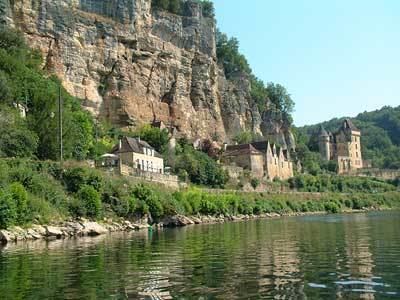Native name La Dordogne Length 483 km Bridges Pont de pierre | Discharge 450 m³/s | |
 | ||
Main source Massif Central1,720 m (5,640 ft) Basin size 23,870 km (9,220 sq mi) | ||
The Dordogne (Occitan: Dordonha, French: La Dordogne) is a river in south-central and southwest France. The Dordogne and its watershed were designated Biosphere Reserve by UNESCO on July 11 2012.
Contents
Map of Dore, France
NameEdit
Contrary to appearances, the name of the Dordogne is not a recent word resulting from the frequent names of the Dore and the Dogne. It comes from an ancient Durānius, derived from a Pre-Celtic root dur-, dor- (as the Durance).
The medieval forms adopted a redoubled suffix -ononia: Dorononia fluvius (sixth century), Dornonia (eighth century) that evolves in Dordonia (ninth century) by a phenomenon of dissimilation, giving the impression of an etymology *Dore-Dogne.
GeographyEdit
The river rises on the flanks of the Puy de Sancy at 1,885 metres (6,184 ft) above sea level in the mountains of Auvergne, from the confluence of two small torrents above the town of Le Mont-Dore: the Dore and the Dogne. It flows generally west about 500 kilometres (310 mi) through the Limousin and Périgord regions before flowing into the Gironde, its common estuary with the Garonne, at the Bec d'Ambès ("Ambès beak"), north of the city of Bordeaux.
NatureEdit
The Dordogne is one of the few rivers in the world that exhibit the phenomenon of a tidal bore, known as a mascaret.
The upper valley of the Dordogne is a series of deep gorges. The cliffs, steep banks, fast flowing water and high bridges attract both walkers and drivers. In several places the river is dammed to form long, deep lakes. Camp sites and holiday homes have proliferated wherever the valley floor is wide enough to accommodate them.
Below Argentat and around Beaulieu-sur-Dordogne, the valley widens to accommodate fertile farmland, well-watered pasture and orchards. In the towns, which are major tourist attractions because of their history and architecture, the quaysides are lined with eating and drinking places. In Périgord, the valley widens further to encompass one of France's main gastronomic regions, with vineyards, poultry farms and truffle-rich woodlands.
The main season for tourism in the Valley of the Dordogne is from June to September, with July and August being high season. The lifestyle and culture of the Dordogne valley attract both visitors and incomers from all over France, but also from many other countries, particularly Britain and Germany.
CourseEdit
The départements of France through which the Dordogne runs, together with some towns in those départements that are on or quite near the river, are as follows:
TributariesEdit
Main tributaries from source to mouth:
N.B. : (R) = right tributary; (L) = left tributary
ActivitiesEdit
Aside from the usual activities such as tennis and golf available in many areas of France, there are a number of water-related activities related to the Dordogne, including:
